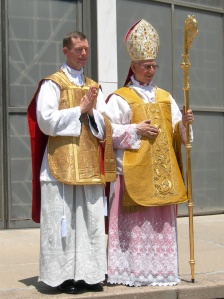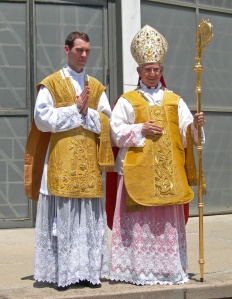Interview with Cardinal Castrillón on the Motu Proprio
Cardinal Darío Castrillón Hoyos has granted an interview to L'Osservatore Romano. (Since the articles there stay only up for a day, see also here on the Papa Ratzinger blog).
I have now translated the entire piece by Gianluca Biccini. I have highlighted some especially interesting, important and/or beautiful passages.
I have now translated the entire piece by Gianluca Biccini. I have highlighted some especially interesting, important and/or beautiful passages.
In the Liturgy the Sense of Catholicity and Unity
"Benedict XVI's apostolic letter Summorum Pontificum on the use of the Roman liturgy prior to the reform carried out in 1970 is making return to full communion with Rome also some non-Catholics. Requests in this sense are arriving after the pope has renewed the possibilty to celebrate according to the old rite." This says cardinal Darío Castrillón Hoyos, president of the Pontifical Commission Ecclesia Dei, who in this interview with our newspaper, after the publication of the papal document on Acta Apostolicae Sedis, clarifies its contents and highlights its importance as a means to conserve the treasure of the liturgy that dates back to St. Gregory the Great and for a renewed dialogue with those who, because of liturgical reform, have distanced thmeselves from the Church of Rome. The publication on the Acta preceded by a few days the appointments by Benedict XVI of Monsignor Camille Perl, the previous secretary, as vice president of Ecclesia Dei, and of Monsignor Mario Marini, the previous adjunct secretary, as secretary.
The letter, in the form of motu proprio, does not refer to the present normal form - the ordinary form – of the Eucharistic liturgy, which is that of the Roman missal published by Paul VI and then reissued on two occasions by John Paul II, but refers to the use of the extraordinary form, which is that of the missale Romanum prior to the Council, published in 1962 with the authority of John XXIII. This is not a case of two different rites, but of a twofold use of the one Roman rite. It is the form of celebration – explains the Colombian cardinal - "that has been used for more than 1400 years. This rite, which we could call Gregorian, has inspired the Masses of Palestrina, Mozart, Bach and Beethoven, great cathedrals and wonderful works of painting and sculpture."
"Thanks to the motu proprio not a few have requested the return to full communion and some have already returned - the president of Ecclesia Dei adds -. In Spain, the "Oasis of Jesus the Priest", an entire cloistered monastery with thirty sisters led by their founder, has already been recognized and regularized by the Pontifical Commission; then there are cases of American, German and French groups on their way of regularization. Lastly there are single priests and lay people who contact us, write to us and call us for a reconciliation, and on the other hand there are so many other faithful who express their gratitude to the pope and their gladness for the motu proprio."
Osservatore Romano: Some have accused the Pope of wanting to impose a liturgical model in which the language and gestures of the rite appear as the exclusive monopoly of the priest, while the faithful would be extraneous and therefore excluded from a direct relationship with God.
Cardinal Castrillón: On the occasion of the Baptism of the Lord, for example, Benedict XVI actually celebrated in the Sistine Chapel with the face towards the crucifix. The Pope celebrated in Italian according to the ordinary form, which does not exclude, however, the possibility of celebrating towards the altar and not versus populum, and which also foresees celebration in Latin. Let us remember that the ordinary form is the Mass that normally all the priests say, according to the post-conciliar reform; while the extraordinary form is the Mass prior to the liturgical reform, which according to the motu proprio today everyone can celebrate, and which has never been prohibited .
OR: Yet some criticisms seem to come even from bishops?C: One or two have difficulties, but those are a few exceptions, because most agree with the Pope. Rather, we find expressed some practical difficulties. We need to be clear: this is not a return to the past but a step forward, because this way you have two treasures, rather than only one. This treasure, therefore, is being offered, respecting the rights of those who are particularly attached to the old liturgy. There then may follow some problems to be solved with common sense. For instance, it can happen that a priest does not have the appropriate preparation and cultural sensitivity. Only think of priests that come from areas where the language is very different from Latin. But this does still not mean a rejection: it is the presentation of a real difficulty, which is to be surmounted.
Our own Pontifical Commission is thinking about organizing a form of aid to seminaries, to dioceses and to bishops' conferences. Another possibility being studied is to promote multimedia resources for coming to know and learning the extraordinary form with all the theological, spiritual, and artistic richness also linked to the ancient liturgy. Furthermore it seems important also to involve groups of priests who already use the extraordinary form, who will offer thmeselves both to celebrate and to demonstrate and teach the celebration according to the missal of 1962.
OR: So the problem does not exist?
C: It is rather a dispute which has arisen from acertain lack of knowledge. Some ask permission for example, as if it were a concession or an exceptional case, but there is no need: the Pope has been clear. It is a mistake of some people and some journalists to believe that the use of the Latin language pertains only to the ancient rite, whereas, to the contrary, it is also foreseen in the missal of Paul VI.
Through the motu proprio "Summorum Pontificum" the Pope offers to all priests the possibility to celebrate Mass in the traditional form, and to the faithful to exercise the right to have this rite when the conditions specified in the motu proprio are met.
OR: How have groups such as the Fraternity of St. Pius X reacted, which refuses to celebrate the novus ordo Mass established after the Second Vatican Council?
C: The Lefebvrians from the outset have maintained that the old form had never been abolished. It is clear that it has never been abrogated, although before the motu proprio many have deemed it forbidden. But now, it may be offered to all the faithful who wish it, depending on the possibilities. But it is also clear that if there is not a priest adequately prepared, it can not be offered because it is not only about the Latin language, but also about knowing the old use as such. We must comprehend some differences: the larger room for silence for the faithful, that fosters contemplation of the mystery and personal prayer. Finding again spaces of silence is today for our culture not only a religious necessity. I remember having participated as a bishop in a high-level business management course, where there was talk of the need for the manager to have available a half-dark room where to sit down to think before deciding.
Silence and contemplation are necessary attitudes also today, above all regarding the mystery of God.
OR: Eight months have passed since the promulgation of the document. It is true that it has attracted a lot of supporters also in other ecclesial realities?
C: The pope offers to the Church a treasure which is spiritual, cultural, religious and catholic. We have received letters of agreement also from prelates of the orthodox churches, from anglican and protestant faihtful. Lastly there are some priests of the Fraternity of Saint Pius X who, singly, are seeking to regularize their position. Some of them have already signed the formula of adhesion. We are informed that there are traditionalist lay faithful, close to the Fraternity, who have begun to frequent Masses in the older rite offered in the churches of the dioceses."
OR: How is a return to "full communion" possible for people who are excommunicated?C: The excommunication concerns only the four bishops, because they have been ordained without the mandate of the Pope and against his will, while the priests are only suspended. The Mass they celebrate is without a doubt valid, but not licit and, therefore, participation is not recommended, unless on a Sunday there should be no other possibilities. Certainly neither the priests, nor the faithful are excommunicated. Let me reiterate in this regard the importance of a clear understanding of things to be able to judge correctly.
OR: Do you not fear that the attempt to bring back inside the Church men and women who do not recognize the II Vatican Council could provoke an alienation in those faithful who see in Vatican II a compass for navigating the barque of Peter, especially in these times of constant changes?
C: First of all, the problem regarding the Council is not, in my opinion, as grave as it might seem. In fact, the bishops of the Fraternity of St. Pius X, headed by Monsignor Bernard Fellay, have expressly recognized Vatican II as an Ecumenical Council and Monsignor Fellay has reiterated this in a meeting with Pope John Paul II, and more explicitly in the audience of 29 August 2005 with Benedict XVI. Nor can it be forgotten that Monsignor Marcel Lefebvre has signed all the documents of the Council.
I think their criticism of the council concerns rather the clarity of certain texts, in the absence of which the way is opened for interpretations which are not in accordance with the traditional doctrine. The biggest difficulties are interpretative in nature or have to do with some gestures in the ecumenical field, but not with the teaching of Vatican II. These are theological discussions, which may take place inside the Church, where in fact there are different discussions regarding the interpretation of the texts of the Council, discussions which can continue also with the groups returning to full communion.
OR: So the Church extends her hands to them, also through this new motu proprio on the ancient liturgy?
C: Yes, certainly, because it is precisely in the liturgy that the whole sense of Catholicity is expressed and it [the liturgy] is a source of unity. I really like the novus ordo which I celebrate daily. I had not celebrated anymore according to the missal of 1962, after the post-conciliar liturgical reform. Today in resuming sometimes the extraordinary rite, I myself have rediscovered the richness of the old liturgy that the Pope wants to keep alive, preserving that age-old form of Roman tradition.
We must never forget that the ultimate point of reference in the liturgy, as in life, is always Christ. We have therefore no fear, also in the liturgical rite, to turn towards Him, toward the crucifix, together with the faithful, to celebrate the holy sacrifice, in an unbloody manner, as the Council of Trent has defined the Mass.
fonte:new liturgical movement

His Eminence with Ordinati
His Eminence and Fr. Jared McCambridge, FSSP
His Eminence and Fr. Dennis Gordon, FSSP
His Eminence and Fr. Justin Nolan, FSSP
His Eminence and Fr. Jonathan Romanoski, FSSP
In Lincoln, Nebraska at the Cathederal of the Risen Christ, His Eminence, Dario Cardinal Castrillon Hoyos ordained four new Priest for the Priestly Fraternity of Saint Peter. The following day, His Grace, Archbishop Malcolm Ranjith ordained 8 Deacons for the Fraternity in Germany.
Laudetur Jesus Christus
fonte:una voce carmel



























